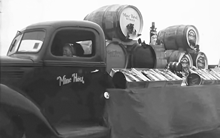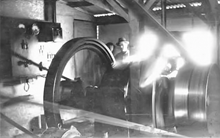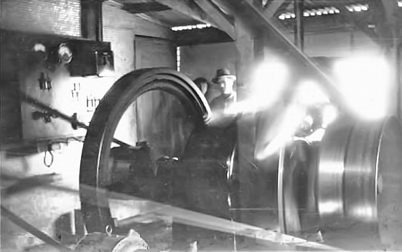|
1930 Vintage Crush 19,489 Tons
Friday March 14th 1930
Prime Minister Scullin, under pressure from the industry introduced a Bill to increase the existing bounty of 1/- per gallon on sweet wine exported to 1/6 per gallon. To assist the position of the Overseas Marketing Board with administrative and publicity purposes a levy was struck at 3/- per ton on all fresh grapes used to produce wine, and 9/- per ton on all dried grapes delivered to distilleries and used in the manufacture of wine. Statistics showed that Australia in 1929, had exported a total of 2,186,699 gallons of wine to Great Britain, which was in a depression. Stocks of Australian wine in Bond in Great Britain on last December 31st totaled 2,035,000 gallons out of a total of 6,961,000 gallons.
Friday March 28th 1930
The Federal Viticultural Council has protested against the proposed increase of excise duty on fortifying spirit from 5/- and 6/- per gallon to 10/- and 11/- per gallon. The principal objections were:- Taxation is doubled in a time of stress The rate was disproportionate to the increase in the bounty Winemakers will have problems seeking additional finance The end result will be decreased profit for winemakers It would be totally unfair to charge the increased excise on spirit already in bond It was also pointed out that that figures of the last 5 years supplied by the Minister were about half of the actual revenue received.
Friday April 25th 1930
A five year total of all wines exported to June 30th 1929 was 11,190,681 gallons, of which approximately 7,657,533 gallons were sweet wines on which bounty was paid.
In this period 8,113,063 gallons of fortifying spirit was produced and revenue amounted to £2,321,935. Stock on hand of fortifying spirit at January 1st 1930 was 1,408,500 gallons.
Friday May 30th 1930
Great Britain stocks of in bond wine as of March 1st this year totaled 6,199,000 gallons and Australia's component was 1,927,000 gallons compared to the same time last year of 2,350,000 gallons. It was an encouraging sign. |
 
|
The lass in the cabin is thought to be Margaret Harrip, daughter of Ray and Edith Harrip in a parade in the 1930's.
|
 
|
Inside the Power House. Unfortunately, I do not know the period or the two people. . |
Friday June 20th 1930
The following are extracts from an address Oscar Weste presented to the Berri Bureau Conference.
Mr. Weste discussed the situation that had been caused by the large planting of the Doradillo vine in the Upper Murray. He highlighted the problems the industry had during the 1901-1904 period. The post war period caused a drastic shortage of wine; with prices of £19 per ton being paid for grapes and thrice for spirit was higher than it had ever before. Some 2,000 acres of Doradillo vines were planted under the Repatriation Scheme against the wishes of all of the winemakers that had endured the 1901-1904 period. The bulk of the Doradillo's were planted in the irrigated districts. This resulted in the Commonwealth Government. in 1924, granting a bounty on all exported sweet wine of greater than 34% proof spirit. A minimal quantity of wine was exported in 1924. In 1925 however, 875,000 gallons were shipped, and in 1926 nearly 1,000,000 gallons, and in 1927 more than 3,000,000 were exported. In 1928 the bounty was reduced and annual spirit stocks that were normally on average of 225,000 gallons rose to 500,000 gallons at end of 1928 and then to 1,000,000 gallons at the end of 1929. See Joe Brown's comment!!!
Mr. Weste went to recommend the alternatives of removing the non productive plantings, Government assistance and reducing stocks of spirit to normal requirements. He quoted Professor Lowrie who, 1910, said "Australia's greatest need is the cultivation of a prosperous Yeomanry and not a fever stricken peasantry"
Friday August 15th 1930
The Hon. J. Gunn, Commonwealth Director of Development and Mr. R. McK. Gollan, Chief Excise Inspector for South Australia visited the Riverland towns and industries for the purpose of these gentlemen submitting a report the Government covering all phases of the Wine Industry addressing Production of Grapes, Manufacture of Wine , Marketing of Wine, Exportation of Wine.
Friday October 31st 1930
By October 1930 the Australian Wine Grape Crush was 80,000 tons and Berri was crushing no less than 20,000 tons. In the early years production was largely fortifying spirit and brandy and each year increasing amounts of fortified sweet being made. The west end Cellar which became known as Block 5 with 66 5,000 gallon tanks was completed and as had been done with Block 3, provision had been made for overhead small wood storage. The outside storage consists of 50 20,000 gallon vats. There are seven brandy stills, 3 continuous, two rectifiers and 2 pot stills.
Mr. Rump, General Manager, will shortly visit Great Britain and Europe.
Friday November 7th 1930
The 1930 vintage in Australia was estimated at 15,705,051 gallons of which South Australia made 12,188,651 gallons. The Australian total compares with 18,600,249 gallons in 1929, 17,302,611and the record production of 20,450,361 gallons in 1927.
Wine in stock at June 30th was, in round figures, 19,200,000 gallons, of which 7,907,000 gallons was in bond.
By 30th November the Block 5 Cellar had been completed holding 66 5,000 gallon concrete tanks with provision of overhead for small wood storage.
Friday December 12th 1930
W. A. Rump, reputed sale of 30,000 gallons in London-returning home. |









